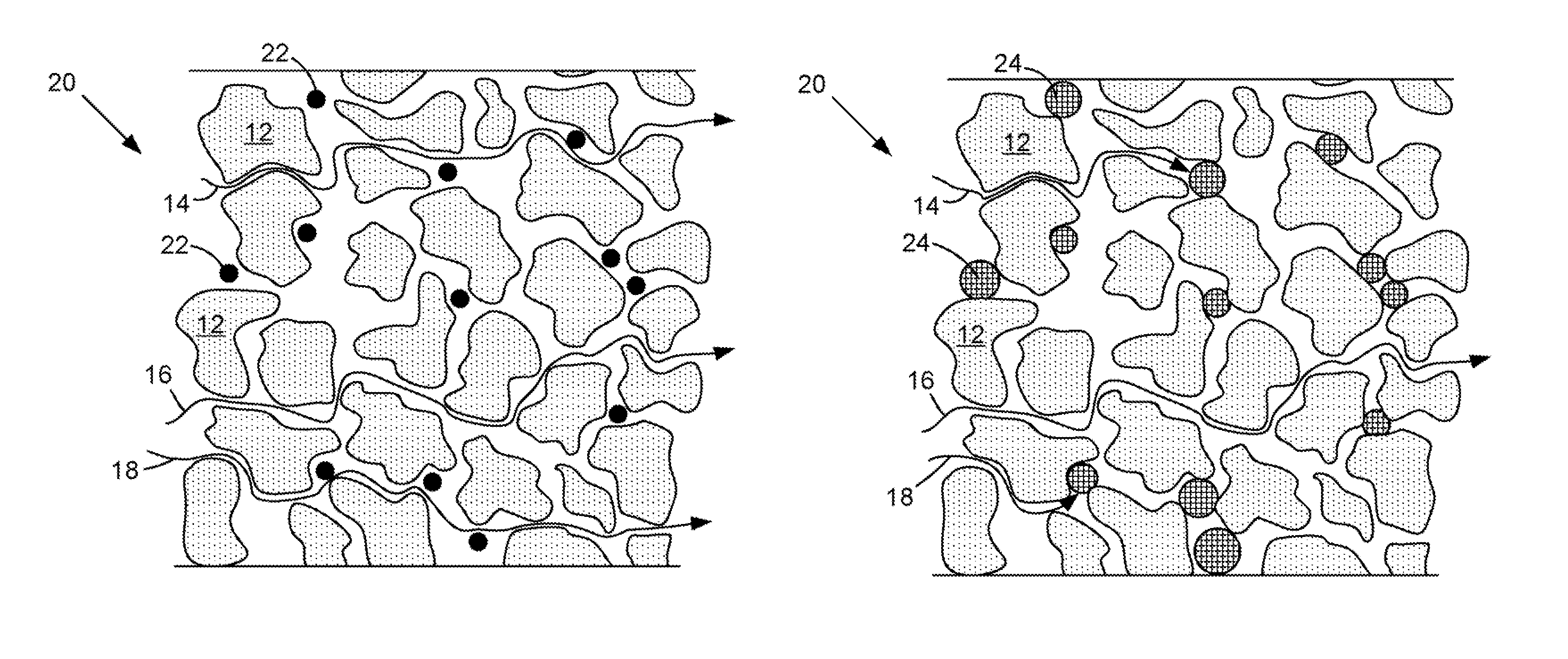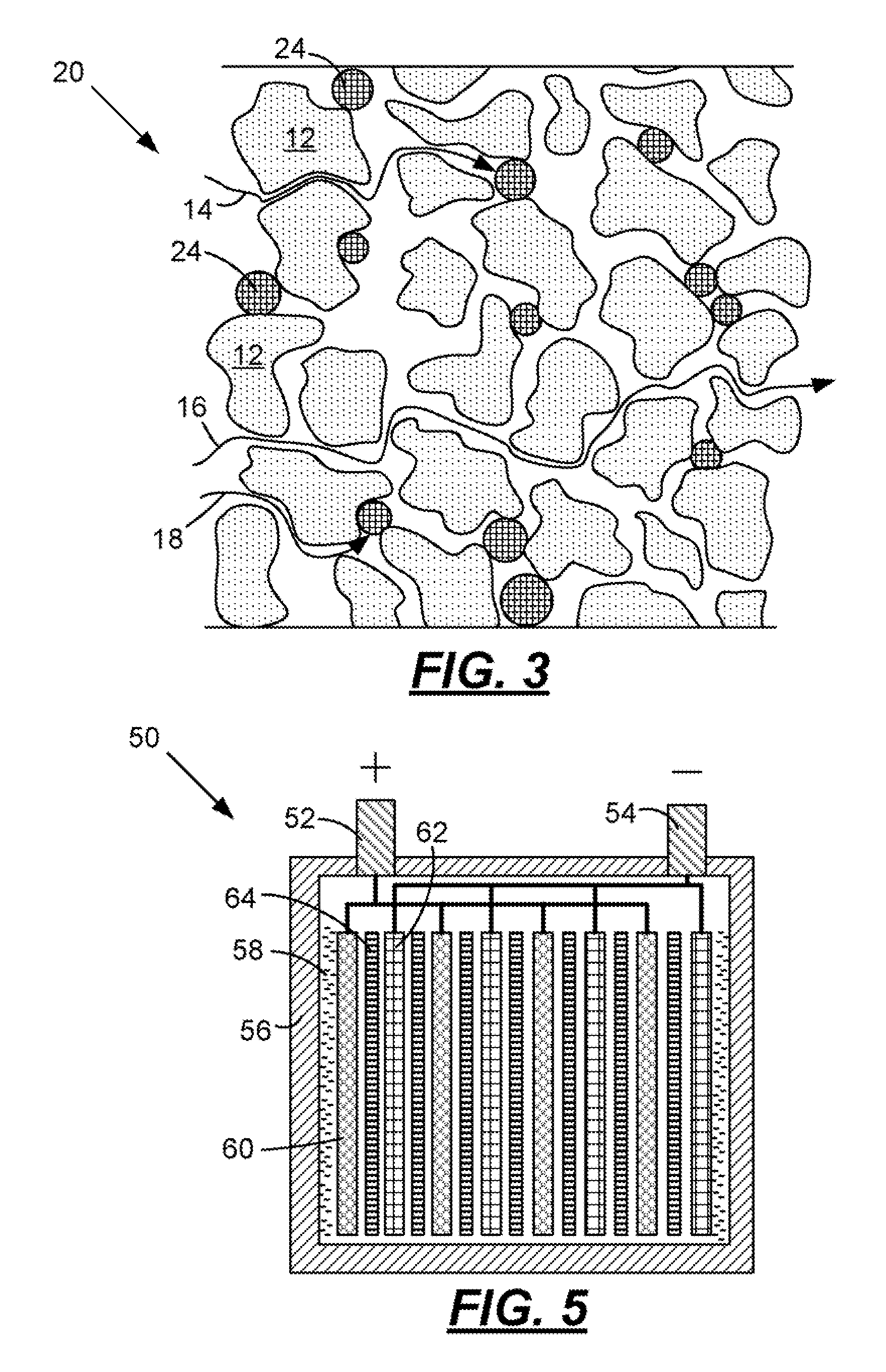Smart battery separators
a technology of energy storage cell and separator, which is applied in the direction of cell components, electrical equipment, cell component details, etc., can solve the problems of affecting the life of the battery, affecting the efficiency of the separator, and affecting so as to improve the electrical resistance of the storage cell, improve the performance of the energy storage cell, and improve the effect of the property
- Summary
- Abstract
- Description
- Claims
- Application Information
AI Technical Summary
Benefits of technology
Problems solved by technology
Method used
Image
Examples
example 1
[0031]When a lead-acid battery is discharged the sulfuric acid electrolyte is temporarily consumed as the positive and negative plates are both converted into lead-sulfate from lead-dioxide and lead respectively. As the discharge proceeds, the formation of lead-sulfate continues and the concentration of the acid decreases making the electrolyte more like water. The acid concentration when measured in units of specific gravity begins at about 1.280 for a fully charged battery and tends toward a specific gravity of 1.000 when the battery is fully discharged. It is widely known that when a lead-acid battery is very deeply discharged the battery should be recharged immediately or the battery life may be compromised. The reason for this is shown in FIG. 4. This figure illustrates a sharp increase in solubility of lead sulfate when the specific gravity of the electrolyte is below about 1.004. Under these conditions the lead-sulfate in the plates may dissolve, diffuse into the separator fi...
example 2
[0034]Separators including electrolyte-sensitive porosity-controlling agents have been made from formulations as set forth in the following table (Samples 1-4). The Control sample did not contain a porosity-controlling agent. In the table, the masterbatch was made from a natural rubber component mixed with pepton in a Banbury mixer until soft and pliable. The other ingredients were mixed with the masterbatch in a Brabender mixer for three to four minutes at a temperature of 24° C. In the table PHR is parts per hundred parts of rubber, DPG is diphenyl guanidine accelerator, SAP 1 is a sodium salt of poly-acrylic acid superabsorbent polymer available from BASF Corporation under the trade name LUQUASORB 1260, and SAP 2 is a sodium salt of poly-acrylic acid superabsorbent polymer available from Emerging Technologies Inc. under the trade name NORSOCRYL D-60. Each of the samples was milled, calendared, and dried under the conditions shown in Table 2. An electron beam was used to cure the ...
example 3
[0039]At cold cranking temperatures the performance of a starting, lighting, and ignition (SLI) battery is typically limited by the electrical resistance (ER) of the separator. At relatively cold temperatures, the ER of the separator is controlled by the porosity of the separator and the conductivity of the sulfuric acid through the separator. In order to lower the ER at the relatively cold temperatures, the particles in the separator should contract in size. Accordingly, particles having a positive co-efficient of thermal expansion (i.e., a material that contracts in the cold) are provided. At freezing temperatures the porosity of the separator increases thereby decreasing the ER of the separator. In the case of an automotive battery separator, the particles 12 are actually ultra-high molecular weight polyethylene that has a coefficient of linear thermal expansion (CLTE) of 130×10−6 / ° K. Suitable materials for particles 22 and 24 may include, but are not limited to, polyvinylidene ...
PUM
| Property | Measurement | Unit |
|---|---|---|
| specific gravity | aaaaa | aaaaa |
| specific gravities | aaaaa | aaaaa |
| specific gravity | aaaaa | aaaaa |
Abstract
Description
Claims
Application Information
 Login to View More
Login to View More - R&D
- Intellectual Property
- Life Sciences
- Materials
- Tech Scout
- Unparalleled Data Quality
- Higher Quality Content
- 60% Fewer Hallucinations
Browse by: Latest US Patents, China's latest patents, Technical Efficacy Thesaurus, Application Domain, Technology Topic, Popular Technical Reports.
© 2025 PatSnap. All rights reserved.Legal|Privacy policy|Modern Slavery Act Transparency Statement|Sitemap|About US| Contact US: help@patsnap.com



